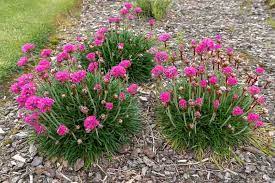Last Updated on August 16, 2023 by Real Men Sow
Armeria maritima, a Plumbaginaceae species of flowering plants, is pretty and easy to grow. This unique flower is known by many common names, including Sea thrift and Marsh daisy, Cushion pink, Marsh daisy and Cliffrose. Sea thrift is a popular ornamental plant because of its irresistible nature. The clump-forming plant produces many colorful flowers that last a long time.
Planting Sea Thrift (Armeria Maritima)
Sea thrift doesn’t care much about the medium it grows in. This plant will thrive in sandy soil with good drainage. You should not make the substrate too fertile as it can make your Sea thrift more prone to crown or root rot.
Mix 2 to 4 inches (5-10cm) of compost or aged horse manure into the medium before planting your Sea thrift. This will increase water retention, drainage, and fertility. You should also feed your Sea thrift twice a year with a balanced liquid fertilizer – once during the active growing season and again in early spring.
As a Potted Plant
Sea thrift is a great potted plant but is very sensitive to waterlogging. It is best to plant it in a container with drainage holes. Sea thrift grows slowly so you won’t need to repot it often. This flower should be transplanted in a larger container only when it outgrows its current pot.
Propagating Armeria Maritima
Sea thrift plants perform best when they are planted in groups or large numbers. The more, the better! These flowers can be easily propagated by division, basal cuttings or seeds. These methods are all very efficient and produce amazing results with little effort.
Spring is the best time to divide your Sea thrift. You simply need to dig your Sea thrift from the soil and divide it into three sections. Then, replant each section wherever you like. However, you cannot divide your plant until it reaches maturity.
You should only propagate your Sea thrift by basal cuttings during summer months. Use a sharp, sterilized knife to cut 2-3 inches (5-7.5cm) of solid stems. Dip the ends of the cut in rooting hormone for best results. Each cutting should be planted in new soil.
General Care Guide for Armeria Maritima
Watering
Sea thrift is a plant that thrives on moisture. It needs regular watering to survive. Too much moisture and soggy conditions can lead to root or crown rot on some specimens. To avoid unpleasant surprises, it is important to have a basic watering schedule.
First, ensure that you check the soil’s moisture every time you water it. You can give your Sea thrift another drink if the substrate’s top 2 to 4 inches (5-10cm) feels dry.
Light & Temperature
This flowering plant likes to be in full sun, but can also tolerate partial shade. The plant needs high levels of light to ensure optimal growth. Armeria maritima plants thrive at temperatures between 60 and 65°F (16°C – 18°C). Nights below 55°F (13°C) will significantly slow down their growth and increase crop times.
Soil & Transplanting
Armeria Maritima splendens grows best in well-drained, rich soil. This plant is not tolerant of moist soil, and it can withstand drought. The plant could die if it is left in moist soil for too long. This plant is short-lived because it thrives on fertile soils, clay and prolonged moist soils. It can live for many years if it is given the right environment in full sunlight.
Pruning
To enhance its growth, it should be killed. It is better to remove it from the center if it is rotting. Split the plant and discard the rotten middle. Replant the healthy parts. This plant is always green, so it should not be pruned in the fall. Instead, remove all dead leaves during spring.
Pest and Plant Diseases of Armeria Maritima
This plant is resistant to deer and can grow disease-free and pest-free. Crown rots can be prevented by paying attention to winter wetness and poor drainage. Also, be on the lookout for rust.

